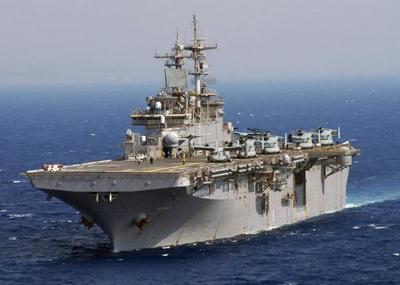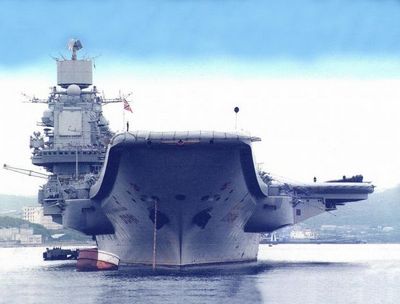30.08.10
Text: RusNavy.com, D. Yerofeev
It is necessary to specify at once that a new Russian aircraft carrier can not be smaller (in dimensions and so in displacement) than Russia's the only operable carrier Admiral Flota Sovetskogo Soyuza Kuznetsov (Project 1143.5, total displacement is 58,500 tons, extreme length is 304.5 meters). We state this specially for adherents of "light", "small" and other aircraft carriers with displacement not more than 35,000 tons.
| Tell a friend | Print version |
|---|
Home / Science / Scientific problems of shipbuilding / How should Russian flattop look like? / Part IV. What kind of carriers and fighters do we need?
Part IV. What kind of carriers and fighters do we need?
As is known, extreme dimensions of an aircraft carrier primarily, length, beam and, hence, displacement, since all those parameters are closely related to each other depend much on flight deck size. In its turn, size of a flight deck providing all takeoff and landing operations, pre- and post-flight maintenance and etc. depends on weight and flight characteristics of aircrafts based on it. Aircrafts need space for taking off and landing. And the heavier an aircraft, the more space it needs. This is most critical for ski-ramp takeoff, when a fully loaded and fueled aircraft needs very long runway. Normally, catapult track is somewhat over 90 meters.
Obviously, new carrier will be badly in need of a new deck-based fighter, more advanced than Su-27K (which prototype, T10K-1, performed its first flight as early as 1987). Moreover, there is need not for one aircraft but the whole family including long-range radar warning aircraft, electronic countermeasures aircraft, reconnaissance aircraft and then some. By the way, according to statements of top-ranking military officials, air group of future aircraft carrier will include both piloted and unmanned aerial vehicles. It is too early to say what kind of aircraft systems they would be; reportedly, tender for future deck-based fighter will be held in 2010. However, it is absolutely clear that aviation- and maritime-oriented design bureaus should work in tight gear while developing a new "decker" without hogging the blanket like it was many times in our history.

USS Wasp amphibious assault ship.
It is entirely possible that some day VTOL aircrafts could find a niche in deck-based aviation development program. In particular, they are perfect for tasks which are assigned for such planes in U.S. Marine Corps support of landing troops, being based at "bandboxes" like temporary airfields and spacious decks of amphibious ships. In this connection, we can recall American landing ships (essentially, landing aircraft carriers) of such classes as America, Wasp, and Tarawa which have displacement about 40,000-50,000 tons and fly-through deck. This makes it possible to carry helicopters which provide vertical envelopment, and VTOL aircrafts capable to maintain close-in support of airdrops and when 5-gen fighter F-35B is commissioned partially perform air defense tasks.
So why don't we build a dozen "toy carriers" with displacement, say, 25,000-30,000 tons instead of two or three ships capable to carry 80-90 aircrafts and having displacement of 90,000-100,000 tons? That wouldn't need any substantial efforts to expand shipbuilding infrastructure and learn innovative technologies. That would be cheaper, and there's a plenty of basing sites for such ships. Finally, do we really need an American-like gigantomania? "Imperial ambitions" are history, after all.
However, the fact is that it isn't as money-saving issue as it seems. In terms of shipbuilding, maintenance, and basing costs, those 10 "shiplets" will be at least 2-2.5 times more expensive than three full-fledged carriers.
For another thing, a large aircraft carrier is more preferable a priori, since it is capable to perform combat missions in worse weather conditions than a ship with smaller displacement. As is known, takeoff and landing operations are limited by ship's motion parameters and acceleration factors in flight deck's end points. It is apparent that a ship with displacement of 80,000-100,000 tons will be much less swung than a 3-time smaller "cockleshell". Also, deck watering (to be more precise, the absence of it at a large carrier in conditions of North Atlantic and North Pacific deployment zones of our Northern and Pacific fleets) is of great importance, as well as remoteness of on-board elevators from water surface.
It bears repeating that today aircraft carriers are the only class of surface ships which can be defined as multipurpose ones. It stands to reason that displacement of multipurpose or universal ships must have some certain limits, just like notorious stealth vessels which are relatively small ships corvettes and frigates. Afterwards, it is more reasonable to choose the "division of labor", i.e. differentiation; and to build ships which all systems and arms are priority-oriented on one task (the rest of tasks are minor and contributory). The brilliant example is ASW ships; their primary equipment is submarine detection facilities and antisubmarine weapons; the rest of arms serve only as a self-defense means.
But a ship heavily armed with all types of weapons antisubmarine, antiaircraft, artillery etc. won't be capable to perform none of assigned functions properly. The exception is aircraft carriers the only large warships which can be rightfully considered multipurpose ones. Only carriers can effectively accomplish several diametrically opposite tasks at once. Again, the question is only large aircraft carriers (formerly called attack carriers). They are entirely oriented on use of aviation and do not carry any other weapons except close-in AD systems.
Speaking of sizes, it is appropriate to give an example. During planning and conducting war games, Western experts came to a conclusion that an aircraft with displacement about 40,000 tons is applicable only in local wars and only in regions reliably covered by army aviation and escort ships. But such ship appears to be inefficient while protecting a task force from aerial attack and delivering strikes upon coast targets. Moreover, at highly intense actions such ships could hang on only several hours.
Acceptable combat stability and 85-90% task performance in full-scale conflict against equivalent enemy are possible only by use of aircraft carriers with standard displacement at least 65,000-70,000 tons. Note that full displacement of future French and British carriers makes 65,000 tons, and the first Soviet/Russian nuclear-powered aircraft carrier Ulyanovsk must have had displacement of 75,000 tons.

Heavy aircraft-carrying cruiser Admiral Flota Sovetskogo Soyuza Kuznetsov.
Multipurpose aircraft carriers of this type are capable to perform variety of tasks protection of task group from aerial attack means and naval strategic nuclear force from enemy's ASW aviation; providing operations of strategic aviation; defeating coastal targets and ships; cover landing operations. Additionally, they have to accomplish such seeming unmanifest missions as regional and strategic deterrence, Russian Navy presence operations in strategic localities of the World Ocean, so-called flag demonstration, and security of sea lanes.
One cannot forget that land-based fighter aviation normally operates at 250-300 miles off the shore which is a quite short range. Besides, there is not always sufficient number of equipped airfields near theater of naval operations. Thus and so, an aircraft carrier becomes a sort of outpost of Russian sea area defense. And what's the good of a bunch of those cheap 30,000-ton "block posts" which would be destroyed at the very first hours of war?
Read more
Table of contents
Part I. The story of Soviet carriers
Part II. Ideological bomb
Part III. And so the need was swelling
Part IV. What kind of carriers and fighters do we need?
Part V. Catapult or ski-ramp?
Part VI. Choosing designer and shipyard
Part VII. Renewed Navy headed by a carrier



